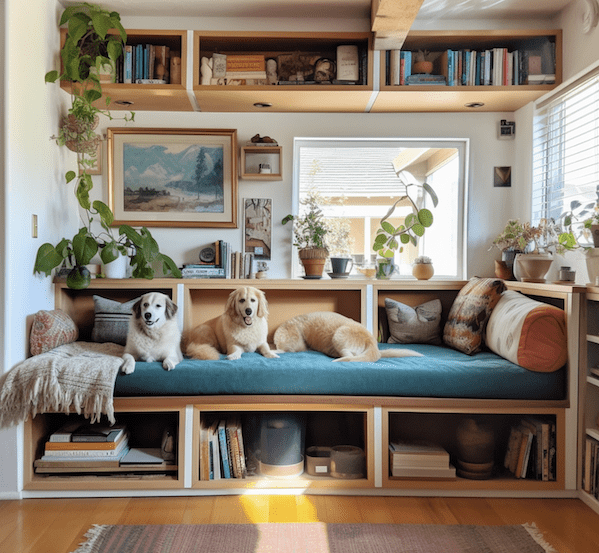Last Updated on June 3, 2023 by Dogs Vets
Small Space Living with Dogs: A Comprehensive Guide
Living with dogs in small spaces such as apartments or tiny homes can be both a joy and a challenge. In this guide, we will offer practical advice and helpful tips to make cohabitating with your furry friends in compact spaces a delightful experience.
Understanding Your Dog’s Needs
Every dog breed is unique, with different needs, temperaments, and energy levels. Some dogs are perfectly content in a smaller space, while others might need more room to roam. When living in a small space with a dog, it’s crucial to understand your dog’s breed and its needs.
Selecting the Right Breed for Small Spaces
When choosing a dog for a small space, consider breeds that are known to adapt well to indoor living.

Smaller breeds, such as French Bulldogs, Cavalier King Charles Spaniels, and Shih Tzus, can thrive in compact spaces. However, size isn’t the only determining factor; some larger dogs like Greyhounds are known for being ‘couch potatoes’ and can adapt to small space living.
Making the Most of Your Space
With some creativity and planning, you can make your compact space a paradise for your pup.
Creating a Dog-Friendly Zone
Designate a specific area in your home for your dog. This space should include a comfortable bed, toys, and a place for food and water. This designated area gives your dog a sense of belonging and security.
Maximizing Vertical Space
Dogs, especially smaller breeds, can benefit from vertical spaces. Consider installing shelves or platforms that your dog can climb, offering more room for exploration and play.
Exercise and Mental Stimulation
Exercise and mental stimulation are crucial for a dog’s well-being, especially when living in a small space.
Regular Walks and Outdoor Activities
Regular walks and outdoor activities can help to satisfy your dog’s need for exercise and exploration. Make it a routine to take your dog out for walks at least twice a day. Visits to the local dog park can also offer socialization opportunities.
Indoor Games and Training
There are numerous games and training exercises that you can do with your dog indoors. Training your dog to follow commands or using puzzle toys can provide much-needed mental stimulation.
Socializing and Training
Socializing and training are equally important in small space living with dogs.
Proper Socialization
Proper socialization can help your dog feel more comfortable in various environments and with different people. Consider enrolling your dog in a local obedience class or doggy daycare for additional socialization opportunities.
Training and Behavioral Management
Training is essential for peaceful coexistence in small spaces. Teach your dog essential commands like “sit,” “stay,” “quiet,” and “go to bed.” Positive reinforcement techniques work best for training.

Managing Noise and Barking
Dogs can be noisy, and in a small space, this noise can be magnified.
Training for Quiet
Train your dog to understand the “quiet” command. You can also use noise-cancelling devices or toys to distract your dog when they start to bark.
Consulting a Professional
If noise continues to be an issue, consider consulting with a professional dog trainer or a behaviorist. They can provide customized solutions for your dog’s specific needs.
Maintaining Hygiene and Cleanliness
A small space can quickly become cluttered and dirty, especially with a dog. Therefore, maintaining hygiene and cleanliness is essential.
Regular Cleaning
Clean your apartment or tiny home regularly. Vacuuming can help get rid of fur and dander, which is especially important for those with allergies. Invest in a good quality vacuum cleaner designed for pet hair.
Pet Grooming
Regular grooming of your dog is also crucial. It not only keeps your dog clean and healthy but also reduces the amount of fur shed inside your home. Consider professional grooming services for a thorough cleanup.
Invest in Easy-to-Clean Furniture and Accessories
When choosing furniture and accessories for your small home, consider those that are easy to clean and maintain. Furniture covers can protect your sofas and chairs from pet hair and messes, and they are usually machine-washable.
Finding the Right Pet Products
Choosing the right products can significantly improve your small space living with dogs.
Choosing the Right Dog Bed
Select a comfortable, high-quality dog bed that suits your dog’s size and sleeping habits. The bed should be a safe haven for your pet within your small living space.
Invest in High-Quality Toys
Investing in high-quality and engaging toys can keep your pet occupied while indoors, reducing their level of anxiety or boredom.
Choose the Right Food and Water Bowls
Choose bowls that are non-slip, easy to clean, and the right size for your dog. Consider elevated dog bowl stands, which are better for your dog’s posture and can also keep feeding areas clean.
Conclusion
Embracing small space living with dogs can be a rewarding experience with the right approach and preparation.
Understanding your dog’s needs, creating a dog-friendly space, ensuring proper exercise and socialization, maintaining cleanliness, and selecting the right pet products are all integral to achieving a harmonious living environment for both you and your pet.
Your dog doesn’t need a mansion to live happily – just a loving home and considerate care.
Additional Resources for Small Space Living with Dogs
Living with dogs in small spaces can feel overwhelming at times, but it’s a journey full of joy and companionship. To make it easier, equip yourself with knowledge and resources. Here are a few online resources that you might find helpful:
- American Kennel Club (AKC): AKC provides resources on understanding different dog breeds, training, nutrition, and more.
- ASPCA Pet Care: ASPCA offers extensive resources on pet care, behavior, and health.
- PetMD: PetMD is a valuable resource for health-related concerns and advice.
- Dog Training Central: This website provides comprehensive resources on dog training.
Final Words
With understanding, patience, and care, you can create a happy and healthy living environment for your dog in a small space.
While the space you have may be small, the love and joy your dog will bring into your life are immeasurable. So here’s to happy small space living with your beloved canine companion!
Remember, every dog and living situation is unique. Always consider your dog’s needs, and don’t hesitate to reach out to professionals such as vets and dog trainers for advice tailored to your situation.
FAQs
What breeds are best for small space living?
Small dogs like Shih Tzus, Bichon Frises, or French Bulldogs often adapt well to smaller spaces. However, some larger breeds like Greyhounds can also thrive in small spaces due to their lower energy levels.
How often should I walk my dog if we live in a small space?
Ideally, dogs should be walked at least once to twice a day, regardless of the size of your living space. Regular exercise is vital for their physical health and mental well-being.
How can I keep my small space clean with a dog?
Regular cleaning, grooming your pet, and investing in easy-to-clean furniture and accessories can help keep your small space clean when living with a dog.
What type of dog bed is best for small spaces?
Choose a dog bed that suits your dog’s size and sleeping habits. There are also various space-saving dog bed designs, such as corner beds or foldable ones that you can consider.
Are there specific dog toys recommended for indoor use?
Toys like puzzle toys, chew toys, and soft plush toys are great for indoor use. Avoid toys that could potentially cause damage, like hard balls that could break things when thrown.
How can I reduce my dog’s noise and barking in a small space?
Training your dog to understand commands like “quiet” can help manage noise. If the issue persists, consider seeking help from a professional trainer or a behaviorist.
What should I feed my dog in a small space living?
Feeding your dog in a small space doesn’t differ significantly from feeding in a larger space. Choose high-quality, nutritious pet food suitable for your dog’s age, breed, and health condition. Always ensure clean water is available. Automatic feeders and water dispensers can be convenient in maintaining consistent feeding schedules and hygiene.
References:

















